Computex 2006: 300W GPUs, Conroe, HDMI Video Cards and Lots of Motherboards
by Anand Lal Shimpi on June 5, 2006 10:24 PM EST- Posted in
- Trade Shows
ASUS' Socket-F and Woodcrest Server Platforms
ASUS' server division was in full force showing off new platforms for both AMD and Intel servers. While ASUS' desktop shipments are approximately 32% AMD and 68% Intel, its server shipments are 40% AMD and 60% Intel reflecting the market appreciation for Opteron.
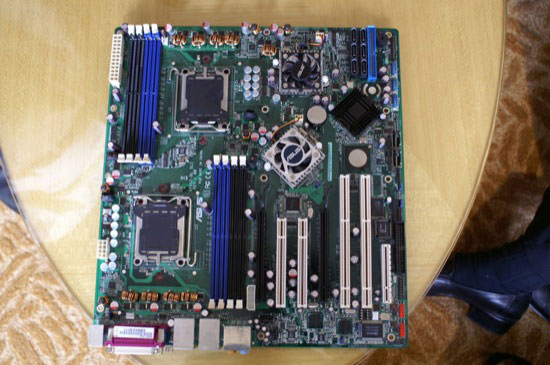 |
| Click to enlarge |
Although all we've talked about lately is AMD's desktop DDR2 platform, Socket-AM2, the server equivalent is only about a month away. Because of the very high pin count (1207 pins), AMD's DDR2 server platform, Socket-F, moved to a LGA style socket similar to what Intel has been using on the desktop since Prescott.
This Socket-F motherboard uses NVIDIA's MCP55 Professional chipset, the server/workstation version of the nForce 590 SLI desktop chipset. The MCP55 + IO55 setup results in two x16 PCIe slots that can be used for a pair of Quadro cards running in SLI mode.
The motherboard also features two mini-SAS connectors, that each can provide four SAS/SATA connectors using a 1-to-4 splitter cable.
Given the server focus of this motherboard, finding two PCI-X slots on board isn't out of the ordinary at all. The Intel PCIe to PCI-X bridge underneath the blurry black heatsink at the top of this picture drives the two PCI-X slots. Who would've expected an AMD server board with a NVIDIA chipset and an Intel PCI-X controller.
ASUS told us that it is working on a passively cooled version of this motherboard that may be ready by the time it ships.
Next up is ASUS' Blackford motherboard for the Xeon platform. Intel's Blackford chipset supports Woodcrest as well as FB-DIMMs.
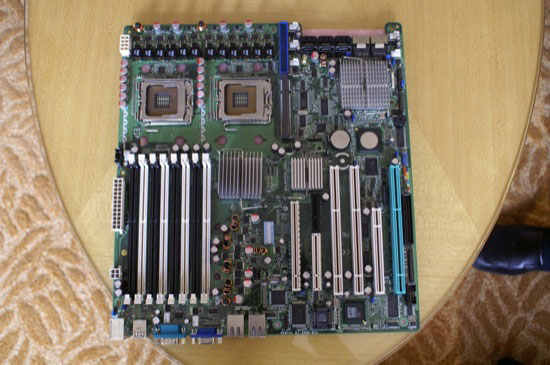 |
| Click to enlarge |
The standard Blackford chipset features a quad channel FB-DIMM memory controller; each white FB-DIMM slot below indicates a separate memory channel:
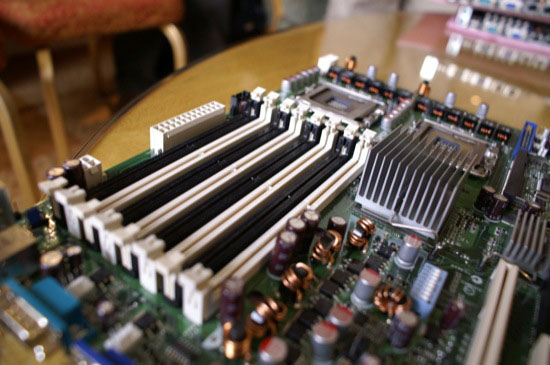
ASUS also has a version of this motherboard based on the Blackford-VS chipset, which only supports two FB-DIMM channels:
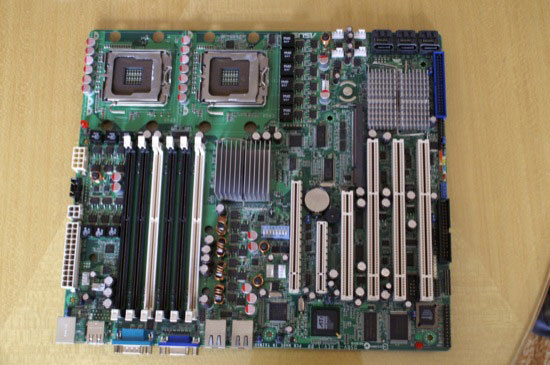 |
| Click to enlarge |
Later this week we will have our own review of Intel's Blackford chipset running Woodcrest, a platform that was officially announced late last month.
Before concluding its presentation, ASUS' server division introduced us to a very clean 1U server based on a Blackford-VS motherboard:
The server is very clean on the inside and features dual redundant power supplies, as well as a completely tool-less design.
There are three LAN ports on the back of the chassis (the one at the right is covered in this picture); the third port is for remote system management, which is very helpful in any enterprise environment.
The LED to the left of the VGA connector illuminates when the server fails so it is easy to pick out when installed in a rack of tens of these servers.
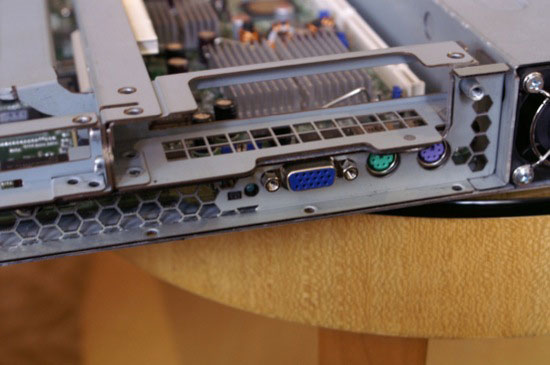
The cooling fans in the server are all easily removable should there be a failure:
There are four hot swappable drive bays at the front of the chassis, all of which support either a SAS or SATA drive.
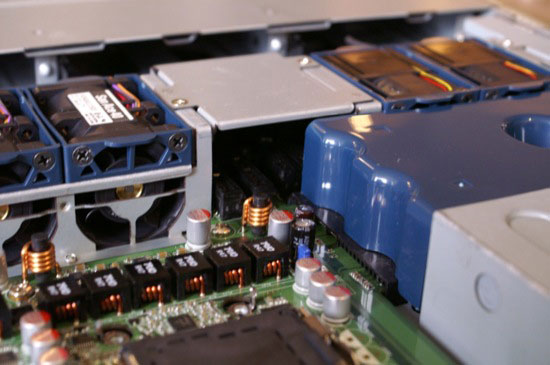


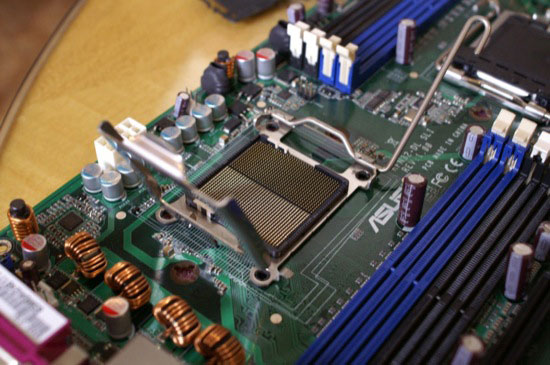

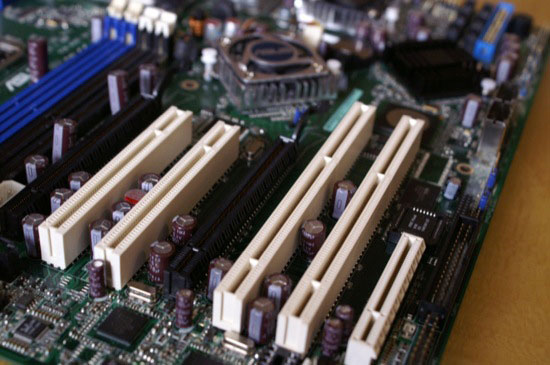
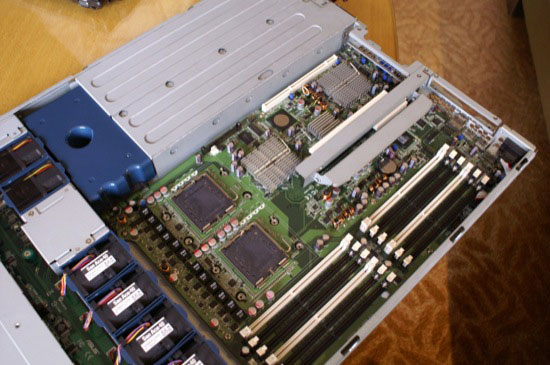

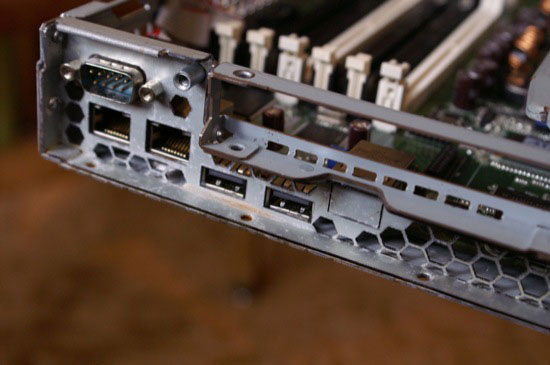
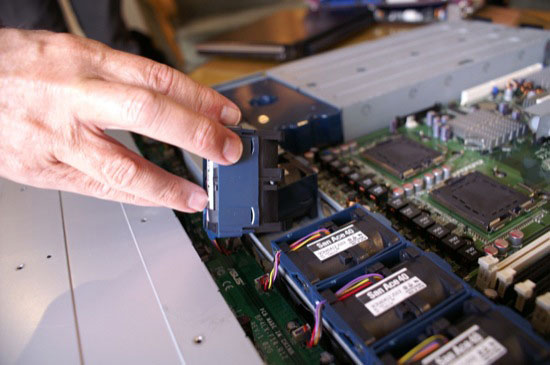








61 Comments
View All Comments
phusg - Tuesday, June 6, 2006 - link
No, transparent side windows already did that ;-)
OCedHrt - Tuesday, June 6, 2006 - link
So what happened to ASRock boards (supposedly page 18)?bongobear - Tuesday, June 6, 2006 - link
I'd like to see what ASRock have lined up as well, however the mini-ITX Albatron boards that were shown in their place were a nice surprise. If they can tweak those a little and get them out at a nice price, very tempting....JarredWalton - Tuesday, June 6, 2006 - link
Anand has a ton of pictures and information from his trip, so he'll probably provide a second update later. However, I've updated the page links to correctly reflect the Albatron content on page 17.Stele - Tuesday, June 6, 2006 - link
There are actually two major types, one (the more common) being filled with solid compound as noted, and are simply called solid electrolytic, or solid aluminium electrolytic capacitors. The other type uses non-solid electrolyte. Both types are better than the usual electrolytic capacitors of course in terms of resistance to high temperatures - generally around 1,500-3,000 hours at 105°C-125°C. Another useful characteristic is that they perform well in high-frequency, high-capacitance applications, which is one reason they've often been used on graphics cards, for example.
They are however not immune from leaking and other capacitor related failures... it's just that they can survive prolonged exposure to higher temperatures for longer periods of time than the regular electrolytic capacitors before they too fail.
This, unfortunately, is non sequitur i.e. it does not follow. Component choice is but one of so many factors in determining the stability, performance and reliability of a product. A cheapo backyard manufacturer could boast 16-phase power, all-Nichicon/Rubycon solid electrolytic caps, Philips MOSFETs and AMP connectors all around but would still fail if the circuits were designed by a half-baked engineer fresh out of college and poorly manufactured. Of course, it could be used by the said cheapo manufacturer as a gimmick to fleece the gullible consumers (of which unfortunately there are very many) who rocket to seventh heaven on seeing such big names. Or a not-so-cheapo manufacturer could make their product more attractive by using such flash while cutting corners on areas where consumers probably won't notice in perhaps the first 6 months of use.
Speaking of gimmick, as mentioned above these capacitors are more useful in high-frequency, high-temperature applications. Naturally not every single circuit nor square inch of a motherboard would call for them and hence the extra cost of 100% solid electrolytic capacitors is unnecessary - they cost in the order of 3-5 times that of regular electrolytic caps, and when added up the savings could certainly be better used elsewhere on the board. For now, at least, other than the circuitries that really could benefit from the solid electrolytic capacitors, I would agree with the other manufacturers that indiscriminate plastering of the board with them is rather more marketing gimmick than engineering.
Viditor - Tuesday, June 6, 2006 - link
Anand/Jarred...I have a few questions if you get time.1. How is the RAS functionality for Woodcrest with the Asus server board?
2. Do the FBDIMMs require active cooling, and if so how much?
3. When Asus released the A8N32-SLI, they hinted at releasing more boards with the 8 phase power...have/will they?
4. Any chance on finding out what the functionality is for the 1207 pins on Socket F?
Cheers! And thanks for the article...!
bob4432 - Tuesday, June 6, 2006 - link
after all this time and the floppy still lives on ...... ;)Calin - Tuesday, June 6, 2006 - link
Floppy is still the only way to load certain drivers for hard drive controllers in Windows (during installation). And as long as this will be the case, the floppy will live onDigitalFreak - Tuesday, June 6, 2006 - link
Fortunately, this problem goes away with Vista. I'm hoping that in a couple of motherboard revs, those damn things will go away.JarredWalton - Tuesday, June 6, 2006 - link
I linked in higher res images for some of the more interesting photos Anand took. If you would like to see any others in more detail, let me know (via email) and I will see about adding those. Note that some images are left in "lo-def" because it reduces blurriness. :)Take care,
Jarred Walton
Editor
AnandTech.com